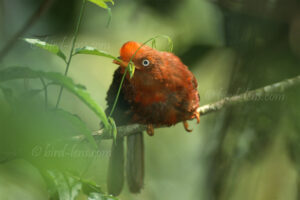 The caravan that sets off from Chailo over a swaying suspension bridge could be perfectly captured in any slave film. It is a humid midday heat when we arrive on an November day at the place that lies at the entrance to the Tunquini Field Station – Chailo. But the legendary Andean Cock-of-the-rock is said to occur here – and that’s worth an extra adventure. Before that, however, you have to cover the distance to the research station on foot – with luggage. So we depend on porters.
The caravan that sets off from Chailo over a swaying suspension bridge could be perfectly captured in any slave film. It is a humid midday heat when we arrive on an November day at the place that lies at the entrance to the Tunquini Field Station – Chailo. But the legendary Andean Cock-of-the-rock is said to occur here – and that’s worth an extra adventure. Before that, however, you have to cover the distance to the research station on foot – with luggage. So we depend on porters.
When we finally finished hitchhiking to Chailo, we find an incredible 3 male residents, which means they could… theoretically help carry. The enthusiasm is written on their faces. The person who claims to be the boss prepares his fishing rod, the other two calmly spread out a tarpaulin on which to dry coffee beans. When my companion, Francoise, remarks that these people don’t have time to carry things because they work, I almost burst into a hysterical fit of crying. Should we spend the rest of the day in this wasteland because we have to watch the coffee beans dry? Francoise shows understanding. Yes, that would be their rhythm, he says. We are put off until tomorrow morning. I can already see us setting up camp for the night under a cart. At some point, as if by a miracle, at least 5 porters – and later even a few more volunteers – come together. We are almost struggling to distribute the burden fairly. Francoise has a clear conscience. The teacher’s wife – who is also going with us – is also allowed to drag along. Actually, I think I heard she’s pregnant – and besides, I don’t need another carrier. But Francoise has a big heart and says he’ll pay her. Now suddenly the “decisive” moment has come. I don’t know why, but the carriers – those who carry – really get going. You cross the river on the swaying footbridge at Chairo. It’s about 5 km to Tunquini on a rather flat, perhaps even passable track on the left side of a mountain stream. The porters get going so well that I almost can’t follow them during all my bird watching. You have to give them that. The way they walk with the heavy camera case on their back and the strap around their forehead is quite remarkable. They can handle boxes so well, a backpack is more likely to cause problems. Of course we see and hear the first birds on the way. An Yellow-olive Flycatcher (Tolmomyias sulphurescens) can be heard (funny, on the CD Birds of Bolivia 2.0 you can only hear recordings around 200 m above sea level; but here we are at a good 1,500 m above sea level). Later – in a mixed flock – we see: Versicolored Barbet (Eubucco versicolor), Spotted Tanager (Tangara punctata), Orange-bellied Euphonia (Euphonia xanthogaster), Slaty-capped Flycatcher (Leptopogon superciliaris) (at least that’s Francoise’s view, which I agree with here, although I think that the wingbars were clearly only spotted and the bird made a very olive overall impression), Buff-throated Saltator (Saltator maximus) (only seen briefly), Yellow-headed Tanager (Tangara xanthocephala), its different from the Birds of Venezuela book Appearance explained to me Francoise with another subspecies (well, yes), Blue-browed Tanager (Tangara cyanotis). In the tree above, a group of Band-tailed Pigeons (Columba fasciata) are feasting on fruit. When I arrive at the station, I can see all my equipment – thankfully this hike I was only armed with binoculars – and the exhausted gang sitting in front of the houses. The field station is real and makes a very good impression. A perfect starting point for the following days!
Tunquini Biological Station is (or was?) a scientific research station in Cotapata National Park in La Paz Province, Bolivia. It is an excellent area of relatively low Yungas Forest (about 1.600 m asl) that can be accessed with the Tunquini Biological Station. The biological research station has a large bedroom, spacious lounges and cooking facilities, which were available during our stay. We arranged the stay there through Luis Pacheco, who is responsible for scientific work in the reserve. I seem to remember that we followed the sign from the road to Rio Selva Resort. 11 km after the junction we passed Rio Selva and soon reached the small village of Chairo. The new main road now runs very close to Chairo (we were there in 2000). From there you follow the path described. The only path through the forest is the continuation of the Chairo path, but it is good for bird watching in both directions.
The Yungas region’s diverse elevational gradients contribute to the variety of bird species found there. Birdwatching in the Yungas offers the opportunity to observe a range of avian life in a beautiful and unique ecosystem. Keep in mind that this list is not exhaustive, and there are many more bird species that call the Yungas region home.
To meet the growing demand for top-of-the-line images of the rarer Palaearctic species, Bird-lens.com strives to expand the range of images of Western Palaearctic birds. Trips to many locations to take pictures of rare western Palearctic birds have been very successful. This nice picture of the blog is just a first impression of what you can find in the gallery in the “Picture Shop” very soon. Please leave a message if bird-lens.com can provide a picture.